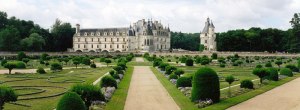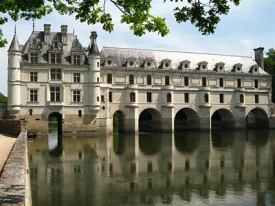Château de Chenonceau

Chenonceau is the most-visited French Château after Versailles, and lies
across the river Cher in the Indre-et-Loire deprtment of the Loire valley.
There had been a wooden mill on this site for centuries, but in 1411, its
owner Jean Marques fell out with the authorities, and his mill was burned to
the ground as a punishment. Marques rebuilt his mill, this time using stone
as a precaution, and also built a small castle as extra insurance - the
first Château de Chenonceau.
In 1513, Marques' heir Pierre sold the castle to pay off his debts. The new owner, Thomas Bohier, didn't like the castle's retro style, demolished it and began work on a new Château in the Late Gothic/Renaissance style - the Château we know today. Bohier's son then ran into debts (the sons aren't doing very well, are they?), the Château was seized by the crown, and in 1547, it was given by Henry II to his mistress Diane of Poitiers. Thus began Chenonceau's long history as 1) a highly suitable gift 2) an A-list party venue.
Diane was very touched by Henri's little present, and added to Chenonceau's splendour with the construction of magnificent gardens and an arched bridge connecting the Château with the far bank of the Cher. When Henri died in 1559, his widow Catherine could finally deal with Diane, the 'other woman' and evicted her from Chenonceau. Whilst Catherine threw ever-more-lavish parites at Chenonceau, poor Diane was forced to 'slum it' in the vast Château de Chaumont. Terrible.
Catherine spent a fortune on Chenonceau, threw France's first fireworks party there in 1560 (she was obviously still devastated by Henri's death the previous year,) and built the Grand Gallery on Diane's bridge, which is the Château's most striking feature today. Building on top of Diane's bridge may have given Catherine a sense of symbolic victory. Sadly for Catherine, it is still known as the Pont de Diane.
 Later on, Chenonceau was given by Henri IV to his mistress Gabrielle
d'Estrées. Gabriele was a devoted mistress, who accompanied Henri on his
military campaigns and made sure he had clean clohes and ate properly after
a battle. The Château then belonged to a banker's daughter, who threw
parties for Voltaire and Rousseau, and to the daughter of Scotsman Daniel
Wilson, who'd made his fortune installing gas lights in Paris. Ms Wilson's
parties, however, were so extravagant, that she had to sell Chenonceau to a
Cuban millionaire, who in turn sold it, in 1913, to the Menier family (of
chocolate fame) who own it to this day.
Later on, Chenonceau was given by Henri IV to his mistress Gabrielle
d'Estrées. Gabriele was a devoted mistress, who accompanied Henri on his
military campaigns and made sure he had clean clohes and ate properly after
a battle. The Château then belonged to a banker's daughter, who threw
parties for Voltaire and Rousseau, and to the daughter of Scotsman Daniel
Wilson, who'd made his fortune installing gas lights in Paris. Ms Wilson's
parties, however, were so extravagant, that she had to sell Chenonceau to a
Cuban millionaire, who in turn sold it, in 1913, to the Menier family (of
chocolate fame) who own it to this day.
Chenonceau is open every day of the year (with slight variations in closing-times,) and costs only 10 €. When you visit, be sure to look up at the ceiling in Diane de Poitiers' bedroom. Propriety dictated that the ceiling be decorated with the initials H (Henri) and C (Catherine, his wife.) However, the initials are interlaced in such a way that they look suspiciously like a D.